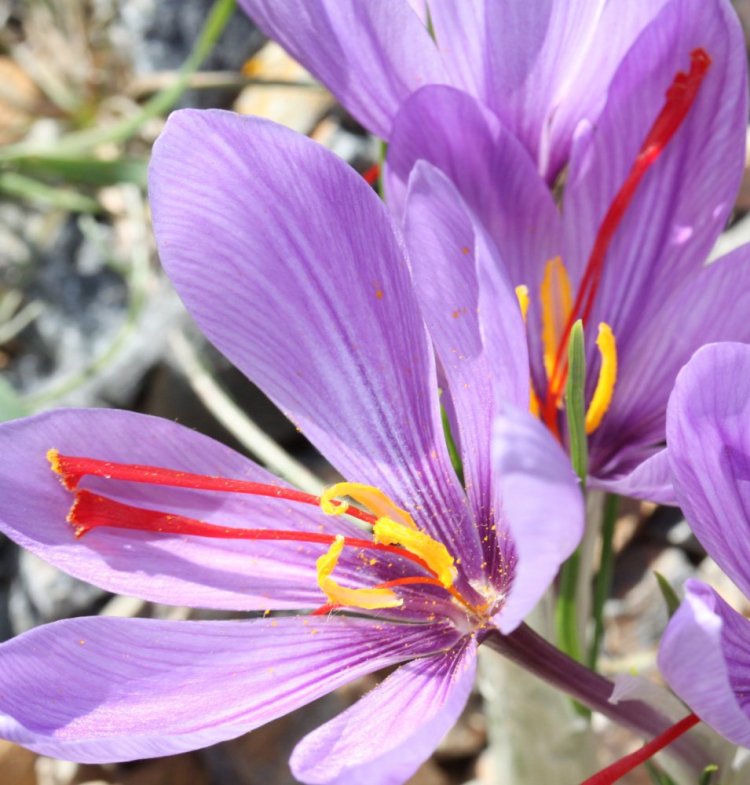Saffron is one of the most exotic – and expensive – spices in the world. Used in such dishes as Spanish paella and Provencal bouillabaisse, saffron retails for about $5,000 a pound.
Unlike most spices, which come from faraway lands like Indonesia and Sri Lanka, saffron can be grown right here in Maine. The spice is the red filaments, also called stigmas, from the pistils of a fall crocus; its botanical name is Crocus sativus.
“If you can grow spring crocus, you can grow fall crocus,” said Peter Johnson, who has been growing saffron in Patten, located in northern Penobscot County about 15 miles west of Houlton, since 2005.
So, if saffron is expensive and easy to grow, why isn’t everyone growing it and getting rich?
“It really is labor intensive to pick it and to separate the flowers from the pistils,” said Margaret Skinner of the Entomology Lab at the University of Vermont, which in March conducted a workshop seeking to promote saffron-growing in North America and ways to produce the spice more efficiently.
In addition, producing that pound of saffron worth $5,000 would require between 50,000 and 75,000 crocus plants. The best growers get about four pounds of saffron per acre.
Saffron plant corms (corms are similar to bulbs) are planted in August, and those plants will sprout and provide some blossoms that first year in late October. The plants stay green all winter until they go dormant in May or June. The mother corm will die at that point, but it will produce daughters that will produce plants the next year.
“If you plant 1,000 corms one year, the following year they will produce 10,000 corms,” Johnson said. He said he lets that process run for about six years, and then digs up the corms and starts over in a fresh field.
When planting, you put the corms six inches deep and plant about six corms per square foot. The daughter corms grow above the mother corm, so over the years the working corms get closer to the surface. In colder areas, people mulch the saffron crocuses over the winter.
The site should have full sun, especially in fall when the crocus flowers, with well-drained pH neutral soil. Saffron crocus want about an inch of rain a week in the fall, just before and while they are flowering.
Harvesting and processing the saffron flowers is the tricky part. To get the best-quality saffron, harvesting should be done early in the day, before the blossoms fully open, according to a sales pamphlet from Roco Saffron, the Dutch company that Johnson works with. Johnson, however, lets some of the flowers open so bees can feed on them because he produces saffron honey as well as saffron itself.
Technically, you can leave the flower on the plant and gently remove the three red stigma from the pistil.
It is more efficient, however, to cut off the entire blossom and go inside, sit at a table or bench and remove the stigma with tweezers or small scissors. The stigma are then dried for 15 minutes at 110 to 150 degrees Fahrenheit (in a food dryer, oven with the door open or direct sunlight) and then placed in an air-tight container away from direct light for at least a month before consumption.
Johnson counters the common argument that growing saffron is labor-intensive – mostly because the harvest season lasts only three weeks.
Most of the people growing saffron in the United States are Amish or Mennonite, said Johnson, who is Mennonite, “and we tend to have large families, so that helps with labor.”
Skinner compared the labor required to grow saffron to that of growing tomatoes, another high-value, high-effort crop.
One advantage of saffron is that no diseases affect the crop, although wood mice and voles like to eat the corms if they can and rabbits will eat the flowers and foliage. The University of Vermont tested the idea of growing saffron in high tunnels in part to keep the pests away, Skinner said. The Roco pamphlet suggests controlling mice and voles by destroying their tunnels and using traps, and controlling rabbits by fencing.
Roco Saffron sells saffron corms with a minimum order of 1,000 for between 19 and 45 cents a bulb, depending on how many and what size you order, while Fedcoseeds in Clinton offers as few as five bulbs for $3 and as many as 100 bulbs for $38. Ordering at Fedco will resume in mid-June.
Even if you aren’t planning to get rich with your saffron, you can enjoy the flowers and maybe grow enough to flavor your paella. Even in Maine, a state obsessed with local foods, local saffron is a nice surprise.
Tom Atwell is a freelance writer living and gardening in Cape Elizabeth. He can be contacted at 767-2297 or at: tomatwell@me.com.
Send questions/comments to the editors.


 PETER JOHNSON, who grows saffron in Patten, gets the most from each flower.
PETER JOHNSON, who grows saffron in Patten, gets the most from each flower.
Comments are no longer available on this story